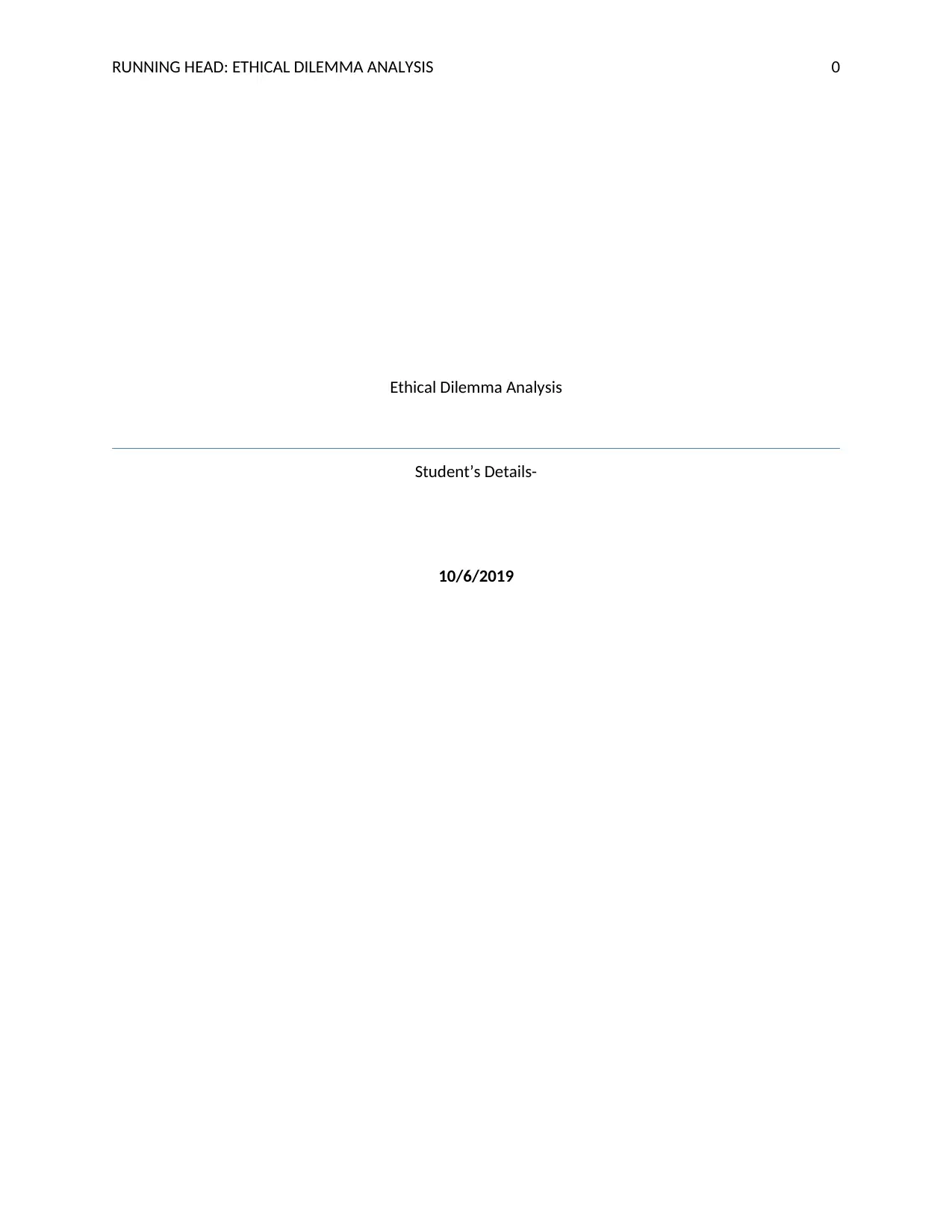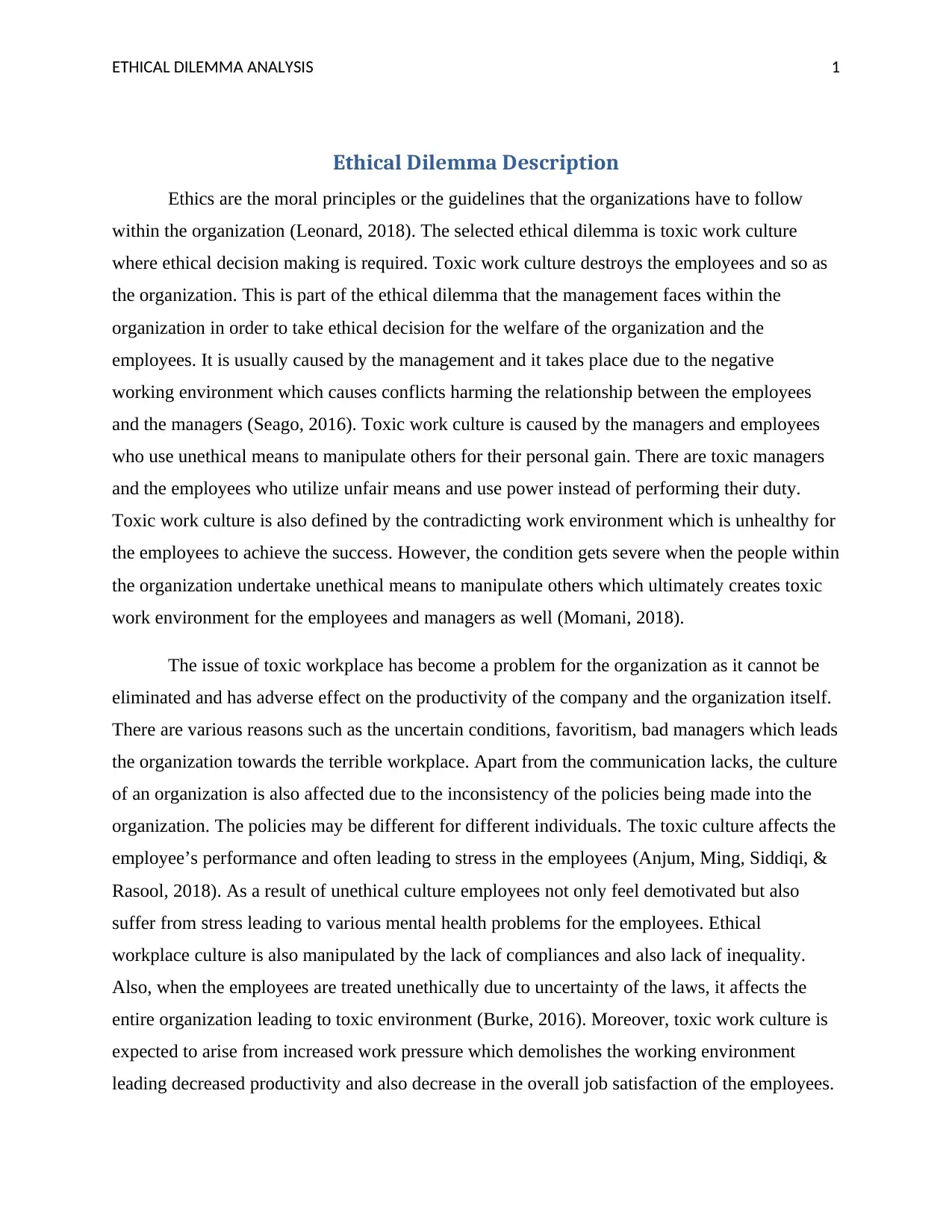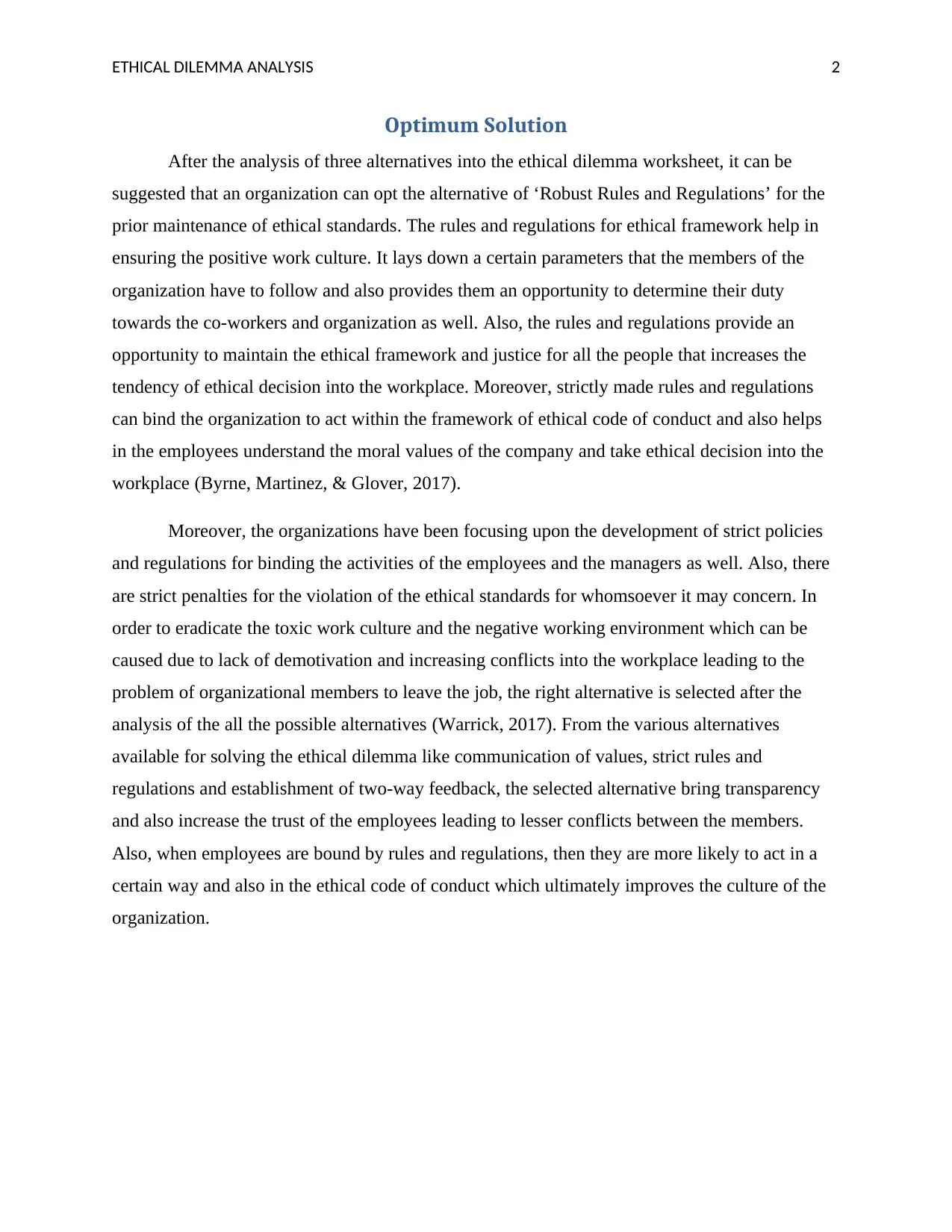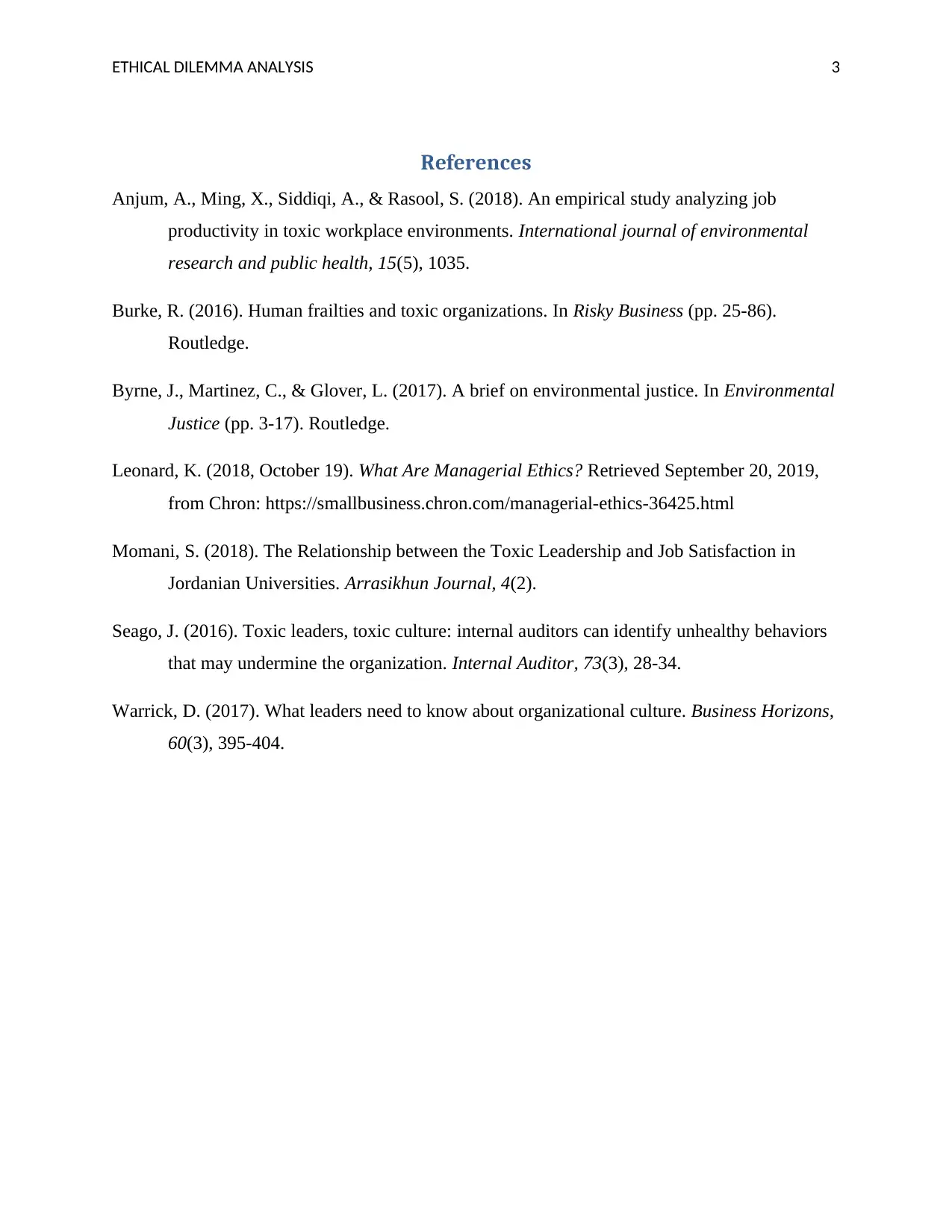BUSN 6011 - Ethical Dilemma Analysis: Addressing Toxic Work Culture
VerifiedAdded on 2022/09/30
|4
|1051
|200
Homework Assignment
AI Summary
This assignment presents an analysis of an ethical dilemma concerning toxic work culture. The student identifies and describes the ethical dilemma, which is characterized by negative working environments, unethical manipulation, and detrimental effects on employee well-being and organizational productivity. The paper explores the causes of toxic work cultures, including poor management, inconsistent policies, and increased work pressure. The assignment then proposes a solution using the ethical framework, focusing on the implementation of robust rules and regulations to maintain ethical standards and foster a positive work environment. The student explains how these rules can increase transparency, build trust, and reduce conflicts, ultimately improving organizational culture. The paper references relevant sources to support its arguments.

RUNNING HEAD: ETHICAL DILEMMA ANALYSIS 0
Ethical Dilemma Analysis
Student’s Details-
10/6/2019
Ethical Dilemma Analysis
Student’s Details-
10/6/2019
Paraphrase This Document
Need a fresh take? Get an instant paraphrase of this document with our AI Paraphraser

ETHICAL DILEMMA ANALYSIS 1
Ethical Dilemma Description
Ethics are the moral principles or the guidelines that the organizations have to follow
within the organization (Leonard, 2018). The selected ethical dilemma is toxic work culture
where ethical decision making is required. Toxic work culture destroys the employees and so as
the organization. This is part of the ethical dilemma that the management faces within the
organization in order to take ethical decision for the welfare of the organization and the
employees. It is usually caused by the management and it takes place due to the negative
working environment which causes conflicts harming the relationship between the employees
and the managers (Seago, 2016). Toxic work culture is caused by the managers and employees
who use unethical means to manipulate others for their personal gain. There are toxic managers
and the employees who utilize unfair means and use power instead of performing their duty.
Toxic work culture is also defined by the contradicting work environment which is unhealthy for
the employees to achieve the success. However, the condition gets severe when the people within
the organization undertake unethical means to manipulate others which ultimately creates toxic
work environment for the employees and managers as well (Momani, 2018).
The issue of toxic workplace has become a problem for the organization as it cannot be
eliminated and has adverse effect on the productivity of the company and the organization itself.
There are various reasons such as the uncertain conditions, favoritism, bad managers which leads
the organization towards the terrible workplace. Apart from the communication lacks, the culture
of an organization is also affected due to the inconsistency of the policies being made into the
organization. The policies may be different for different individuals. The toxic culture affects the
employee’s performance and often leading to stress in the employees (Anjum, Ming, Siddiqi, &
Rasool, 2018). As a result of unethical culture employees not only feel demotivated but also
suffer from stress leading to various mental health problems for the employees. Ethical
workplace culture is also manipulated by the lack of compliances and also lack of inequality.
Also, when the employees are treated unethically due to uncertainty of the laws, it affects the
entire organization leading to toxic environment (Burke, 2016). Moreover, toxic work culture is
expected to arise from increased work pressure which demolishes the working environment
leading decreased productivity and also decrease in the overall job satisfaction of the employees.
Ethical Dilemma Description
Ethics are the moral principles or the guidelines that the organizations have to follow
within the organization (Leonard, 2018). The selected ethical dilemma is toxic work culture
where ethical decision making is required. Toxic work culture destroys the employees and so as
the organization. This is part of the ethical dilemma that the management faces within the
organization in order to take ethical decision for the welfare of the organization and the
employees. It is usually caused by the management and it takes place due to the negative
working environment which causes conflicts harming the relationship between the employees
and the managers (Seago, 2016). Toxic work culture is caused by the managers and employees
who use unethical means to manipulate others for their personal gain. There are toxic managers
and the employees who utilize unfair means and use power instead of performing their duty.
Toxic work culture is also defined by the contradicting work environment which is unhealthy for
the employees to achieve the success. However, the condition gets severe when the people within
the organization undertake unethical means to manipulate others which ultimately creates toxic
work environment for the employees and managers as well (Momani, 2018).
The issue of toxic workplace has become a problem for the organization as it cannot be
eliminated and has adverse effect on the productivity of the company and the organization itself.
There are various reasons such as the uncertain conditions, favoritism, bad managers which leads
the organization towards the terrible workplace. Apart from the communication lacks, the culture
of an organization is also affected due to the inconsistency of the policies being made into the
organization. The policies may be different for different individuals. The toxic culture affects the
employee’s performance and often leading to stress in the employees (Anjum, Ming, Siddiqi, &
Rasool, 2018). As a result of unethical culture employees not only feel demotivated but also
suffer from stress leading to various mental health problems for the employees. Ethical
workplace culture is also manipulated by the lack of compliances and also lack of inequality.
Also, when the employees are treated unethically due to uncertainty of the laws, it affects the
entire organization leading to toxic environment (Burke, 2016). Moreover, toxic work culture is
expected to arise from increased work pressure which demolishes the working environment
leading decreased productivity and also decrease in the overall job satisfaction of the employees.

ETHICAL DILEMMA ANALYSIS 2
Optimum Solution
After the analysis of three alternatives into the ethical dilemma worksheet, it can be
suggested that an organization can opt the alternative of ‘Robust Rules and Regulations’ for the
prior maintenance of ethical standards. The rules and regulations for ethical framework help in
ensuring the positive work culture. It lays down a certain parameters that the members of the
organization have to follow and also provides them an opportunity to determine their duty
towards the co-workers and organization as well. Also, the rules and regulations provide an
opportunity to maintain the ethical framework and justice for all the people that increases the
tendency of ethical decision into the workplace. Moreover, strictly made rules and regulations
can bind the organization to act within the framework of ethical code of conduct and also helps
in the employees understand the moral values of the company and take ethical decision into the
workplace (Byrne, Martinez, & Glover, 2017).
Moreover, the organizations have been focusing upon the development of strict policies
and regulations for binding the activities of the employees and the managers as well. Also, there
are strict penalties for the violation of the ethical standards for whomsoever it may concern. In
order to eradicate the toxic work culture and the negative working environment which can be
caused due to lack of demotivation and increasing conflicts into the workplace leading to the
problem of organizational members to leave the job, the right alternative is selected after the
analysis of the all the possible alternatives (Warrick, 2017). From the various alternatives
available for solving the ethical dilemma like communication of values, strict rules and
regulations and establishment of two-way feedback, the selected alternative bring transparency
and also increase the trust of the employees leading to lesser conflicts between the members.
Also, when employees are bound by rules and regulations, then they are more likely to act in a
certain way and also in the ethical code of conduct which ultimately improves the culture of the
organization.
Optimum Solution
After the analysis of three alternatives into the ethical dilemma worksheet, it can be
suggested that an organization can opt the alternative of ‘Robust Rules and Regulations’ for the
prior maintenance of ethical standards. The rules and regulations for ethical framework help in
ensuring the positive work culture. It lays down a certain parameters that the members of the
organization have to follow and also provides them an opportunity to determine their duty
towards the co-workers and organization as well. Also, the rules and regulations provide an
opportunity to maintain the ethical framework and justice for all the people that increases the
tendency of ethical decision into the workplace. Moreover, strictly made rules and regulations
can bind the organization to act within the framework of ethical code of conduct and also helps
in the employees understand the moral values of the company and take ethical decision into the
workplace (Byrne, Martinez, & Glover, 2017).
Moreover, the organizations have been focusing upon the development of strict policies
and regulations for binding the activities of the employees and the managers as well. Also, there
are strict penalties for the violation of the ethical standards for whomsoever it may concern. In
order to eradicate the toxic work culture and the negative working environment which can be
caused due to lack of demotivation and increasing conflicts into the workplace leading to the
problem of organizational members to leave the job, the right alternative is selected after the
analysis of the all the possible alternatives (Warrick, 2017). From the various alternatives
available for solving the ethical dilemma like communication of values, strict rules and
regulations and establishment of two-way feedback, the selected alternative bring transparency
and also increase the trust of the employees leading to lesser conflicts between the members.
Also, when employees are bound by rules and regulations, then they are more likely to act in a
certain way and also in the ethical code of conduct which ultimately improves the culture of the
organization.
⊘ This is a preview!⊘
Do you want full access?
Subscribe today to unlock all pages.

Trusted by 1+ million students worldwide

ETHICAL DILEMMA ANALYSIS 3
References
Anjum, A., Ming, X., Siddiqi, A., & Rasool, S. (2018). An empirical study analyzing job
productivity in toxic workplace environments. International journal of environmental
research and public health, 15(5), 1035.
Burke, R. (2016). Human frailties and toxic organizations. In Risky Business (pp. 25-86).
Routledge.
Byrne, J., Martinez, C., & Glover, L. (2017). A brief on environmental justice. In Environmental
Justice (pp. 3-17). Routledge.
Leonard, K. (2018, October 19). What Are Managerial Ethics? Retrieved September 20, 2019,
from Chron: https://smallbusiness.chron.com/managerial-ethics-36425.html
Momani, S. (2018). The Relationship between the Toxic Leadership and Job Satisfaction in
Jordanian Universities. Arrasikhun Journal, 4(2).
Seago, J. (2016). Toxic leaders, toxic culture: internal auditors can identify unhealthy behaviors
that may undermine the organization. Internal Auditor, 73(3), 28-34.
Warrick, D. (2017). What leaders need to know about organizational culture. Business Horizons,
60(3), 395-404.
References
Anjum, A., Ming, X., Siddiqi, A., & Rasool, S. (2018). An empirical study analyzing job
productivity in toxic workplace environments. International journal of environmental
research and public health, 15(5), 1035.
Burke, R. (2016). Human frailties and toxic organizations. In Risky Business (pp. 25-86).
Routledge.
Byrne, J., Martinez, C., & Glover, L. (2017). A brief on environmental justice. In Environmental
Justice (pp. 3-17). Routledge.
Leonard, K. (2018, October 19). What Are Managerial Ethics? Retrieved September 20, 2019,
from Chron: https://smallbusiness.chron.com/managerial-ethics-36425.html
Momani, S. (2018). The Relationship between the Toxic Leadership and Job Satisfaction in
Jordanian Universities. Arrasikhun Journal, 4(2).
Seago, J. (2016). Toxic leaders, toxic culture: internal auditors can identify unhealthy behaviors
that may undermine the organization. Internal Auditor, 73(3), 28-34.
Warrick, D. (2017). What leaders need to know about organizational culture. Business Horizons,
60(3), 395-404.
1 out of 4
Related Documents
Your All-in-One AI-Powered Toolkit for Academic Success.
+13062052269
info@desklib.com
Available 24*7 on WhatsApp / Email
![[object Object]](/_next/static/media/star-bottom.7253800d.svg)
Unlock your academic potential
Copyright © 2020–2025 A2Z Services. All Rights Reserved. Developed and managed by ZUCOL.





